- Manufacturer: GH form
- Designer: Knud Holscher
- Material: cast iron
- www.pictoform.dk
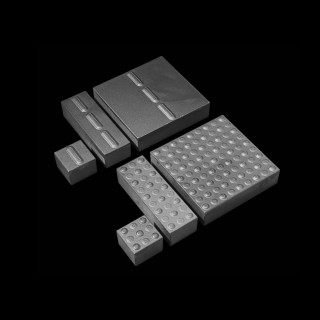
Pictoform® guideline system consists of a series of paving stones with the declared intention of assisting the blind and visually impaired in traversing the city. The paving stones are appliccable for a lot of purposes. They can form a guideline, mark - by the use of a dome area - the shift, for instance from a sidewalk to the road- way, indicate bus stops etc. Particularly the traffic unctions and town centers with their open squares and pedestrian streets may need the guide- line system. Pictoform® is placed following natural courses and tangible to foot and cane. Both the shape of the patterns and the returned sound of the mobility cane's touching the stones, are a part of guiding the blind and visually impaired.
Index
- Knud Holscher Knud Helmuth Holscher (born May 6, 1930 in Rødby, Denmark) is a Danish architect and industrial designer. Holscher studied with Erik Christian Sørense
- GH Form GH Form is a danish manufacturer of street and park equipment. It was founded in 1918. GH form seek to mark themselves through sturdy products primari
- Blindness Blindness is the condition of lacking visual perception due to physiological or neurological factors. Various scales have been developed to describe t
- Blind Pedestrians Street Crossing At any given time, people who are blind or visually impaired can travel and cross streets using a human guide, using a long, white can
- Tactile Paving Tactile paving is a system of textured ground surface indicators found on many footpaths/stairs and train station platforms to assist blind and vision
- Braille The Braille system is a method that is widely used by blind people to read and write. Braille was devised in 1821 by Louis Braille, a blind Frenchman.
- Guide Dog Guide dogs are assistance dogs trained to lead blind or vision impaired people around obstacles. Although the dogs can be trained to navigate various
- Sidewalk A sidewalk (chiefly North American English), pavement (British English, South African English and Philadelphia dialect), footpath (Australian English,
- Accidents Blind man falls to death in New York lift shaft A blind man fell to his death in an lift shaft inside a building with a history of lift violations, an
- Blind Dining Unlike restaurants where people go to see and be seen, diners go to Dans le Noir and other "dark" restaurants around the globe so they can't be seen.
Knud Helmuth Holscher (born May 6, 1930 in Rødby, Denmark) is a Danish architect and industrial designer. Holscher studied with Erik Christian Sørensen and professor Arne Jacobsen at the Royal Danish Academy of Fine Arts, School of Architecture, graduating in 1957. He joined the office of Arne Jacobsen in 1960 and moved to England to oversee construction of Jacobsen's St Catherine's College, Oxford in 1962. Holscher was awarded the British Design Award in 1965 and 1966 for work done in collaboration with Alan Tye before accepting a partnership in established Danish architectural office Krohn and Hartvig Rasmussen, later renamed KHRAS. Knud Holscher retired from KHRAS in 1995 and has since headed his own office Knud Holscher Design.
Though starting out as an architect, it is his work as industrial designer which has brought Knud Holscher international attention and recognition. His designs have been linked to the Hochschule für Gestaltung Ulm and to the work of HfG Ulm student Dieter Rams. In 2003, he said of his work: "Design should be like buttons on a shirt. With character to catch your attention, but no more so than you can use it without thinking about it".
Holscher was professor of architecture at the Royal Danish Academy of Fine Arts from 1968-1988 and professor of design from 1994. He has received numerous awards for his work and is an Honorary RDI, Royal Designer for Industry since 2004.
GH Form is a danish manufacturer of street and park equipment. It was founded in 1918. GH form seek to mark themselves through sturdy products primarily based on basic elements in cast iron. Product development takes place in cooperation with designers, architects or artists and GH Holbæk Iron Foundry. The aim is that cast iron, style-wise and functionally, is updated so that it remains as beautiful and appreciated as additional Danish design. GH Holbæk Iron Foundry is rooted in the far past. Previously all foundries delivered castings to the local community, particularly well goods. For many years, GH Holbæk Iron Foundry exclusively functioned as a subsupplier to the industry, but has now faced the challenge and provides its contribution to recreate the sense of quality and identity of previous times in the public sphere, again in cast iron, but in an idiom of the present. Cast iron is included in most of the products, but other materials such as stainless steel, wood, plastic, bronze, copper, aluminium and rubber facing. GH form do custom tasks as well, such as renovation of cast iron products among other things.
Blindness is the condition of lacking visual perception due to physiological or neurological factors.
Various scales have been developed to describe the extent of vision loss and define blindness. Total blindness is the complete lack of form and visual light perception and is clinically recorded as NLP, an abbreviation for "no light perception." Blindness is frequently used to describe severe visual impairment with residual vision. Those described as having only light perception have no more sight than the ability to tell light from dark and the general direction of a light source.
In order to determine which people may need special assistance because of their visual disabilities, various governmental jurisdictions have formulated more complex definitions referred to as legal blindness. In North America and most of Europe, legal blindness is defined as visual acuity (vision) of 20/200 (6/60) or less in the better eye with best correction possible. This means that a legally blind individual would have to stand 20 feet (6.1 m) from an object to see it—with corrective lenses—with the same degree of clarity as a normally sighted person could from 200 feet (61 m). In many areas, people with average acuity who nonetheless have a visual field of less than 20 degrees (the norm being 180 degrees) are also classified as being legally blind. Approximately ten percent of those deemed legally blind, by any measure, have no vision. The rest have some vision, from light perception alone to relatively good acuity. Low vision is sometimes used to describe visual acuities from 20/70 to 20/200.
By the 10th Revision of the WHO International Statistical Classification of Diseases, Injuries and Causes of Death, low vision is defined as visual acuity of less than 6/18 (20/60), but equal to or better than 3/60 (20/400), or corresponding visual field loss to less than 20 degrees, in the better eye with best possible correction. Blindness is defined as visual acuity of less than 3/60 (20/400), or corresponding visual field loss to less than 10 degrees, in the better eye with best possible correction.
It should be noted that blind people with undamaged eyes may still register light non-visually for the purpose of circadian entrainment to the 24-hour light/dark cycle. Light signals for this purpose travel through the retinohypothalamic tract, so a damaged optic nerve beyond where the retinohypothalamic tract exits it is no hindrance.
Blindness Population
The WHO estimates that in 2002 there were 161 million visually impaired people in the world (about 2.6% of the total population). Of this number 124 million (about 2%) had low vision and 37 million (about 0.6%) were blind.
In order of frequency the leading causes were cataract, uncorrected refractive errors (near sighted, far sighted, or an astigmatism), glaucoma, and age-related macular degeneration. In 1987, it was estimated that 598,000 people in the United States met the legal definition of blindness. Of this number, 58% were over the age of 65. In 1994-1995, 1.3 million Americans reported legal blindness.
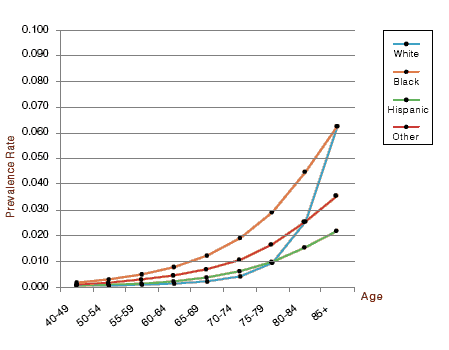
Causes
Most visual impairment is caused by disease and malnutrition. According to WHO estimates in 2002, the most common causes of blindness around the world are:
cataracts (47.9%),
glaucoma (12.3%),
age-related macular degeneration (8.7%),
corneal opacity (5.1%), and
diabetic retinopathy (4.8%), among other causes.
Cure
A pioneering operation has restored the sight of a 70-year-old man and could be a cure for the commonest form of blindness in the western world.
Macular degeneration is a condition where the retina wears out, leaving sufferers with only peripheral vision. It affects two million people in the UK alone, including 40% of people over the age of 75.
Doctors at the St Paul's Eye Unit, Royal Liverpool Hospital, believe they have now developed a cure in what is being called "the single most important surgical development for many years."
The doctors successfully transferred retired dentist John Barr's vision from a worn-out part of the retina to a healthier area, restoring his sight. The critical part of the retina is a tiny patch called the fovea, which is responsible for fine vision.
Chief opthalmic surgeon David Wong said: "Put simply, it is like moving around a carpet which has a worn patch in it and tucking the worn part away."
Macular degeneration is most common amongst older people with 40% of those over 75 in Britain suffering from it.
Sufferers lose their central vision, and with it the ability to read, do close up work and recognise faces.
Until now, doctors could only use laser treatment which at best limited the damage but could not improve sight.
The new operation has been theoretically possible since the early 1990s, but it is only with recent advances in micro-surgerical techniques and instrument design that surgeons have dared attempt it.
Now doctors here and in America and Germany are racing to discover the best surgical approach to help the millions of people with macular degeneration.
Street Crossing
At any given time, people who are blind or visually impaired can travel and cross streets using a human guide, using a long, white cane to identify and avoid obstacles, using a dog guide, using special optical or electronic aids, or using no additional aid. Whatever aid is used, street crossing is comprised of a number of tasks.
1.Locating the Street — First, pedestrians who are blind must determine when they reach a street. This is typically accomplished using a combination of cues, including the curb or slope of the ramp, traffic sounds and detectable warnings.
2. Street Recognition — Next, blind pedestrians recognize or determine which street they have come to. This information is only occasionally provided in any accessible format, so pedestrians who are visually impaired develop a mental map and keep track of where they are within that map, usually by counting blocks and street crossings. Assistance may be sought from other pedestrians.
3. Intersection Assessment — Next, pedestrians who are blind obtain critical information about intersection geometry, including the location of the crosswalk, the direction of the opposite corner, the number of intersecting streets, the width of the street to be crossed, and whether there are any islands or medians in the crosswalk. Vehicular sounds, where there is a stream of traffic on each street at the intersection, are used to infer intersection geometry.
4. Cross the Roadway — After determining the geometry of the intersection, aligning to face towards the destination curb, determining that the intersection is signalized, and having pushed a button (where necessary), pedestrians who are blind must recognize the onset of the walk interval. In the most common technique utilized for crossing at signalized intersections, pedestrians who are blind begin to cross the street when there is a surge of through traffic on the closest side of the street parallel to their direction of travel. Once pedestrians who are blind have begun to cross the street, they must maintain a heading toward the opposite corner. Turning traffic can make it difficult to establish a correct initial heading, and in the absence of traffic on the parallel street, pedestrians who are blind may veer toward or away from the intersection.
Tactile paving is a system of textured ground surface indicators found on many footpaths/stairs and train station platforms to assist blind and vision impaired pedestrians.
Tactile warnings provide a distinctive surface pattern of "truncated domes" or cones (which are small domes or cones that have had their tops cut off, or truncated) or "truncated bars" detectable by long cane or underfoot which are used to alert people with vision impairments of their approach to streets and hazardous drop-offs. People who are blind or visually impaired are alerted of impending danger from vehicle impact or a grade change. There is a disagreement in the design community and the community of users if the interior use of these bars represents a tripping hazard.
The original tactile paving was developed by Seiichi Miyake in 1965. The paving was first introduced in a street in Okayama city, Japan, in 1967. Its use gradually spread in Japan and then around the world.
Originally instituted at crosswalks and other hazardous vehicular ways by countries like Japan, the United Kingdom and Australia, among others, the United States picked up the standard in the early 1990s, after passage of the Americans with Disabilities Act (ADA). Canada started incorporating the use in transportation first in the 1990s then added them to the built environment in early 2000s.
The Braille system is a method that is widely used by blind people to read and write. Braille was devised in 1821 by Louis Braille, a blind Frenchman. Each Braille character or cell is made up of six dot positions, arranged in a rectangle containing two columns of three dots each. A dot may be raised at any of the six positions to form sixty-four (26) permutations, including the arrangement in which no dots are raised. For reference purposes, a particular permutation may be described by naming the positions where dots are raised, the positions being universally numbered 1 to 3, from top to bottom, on the left, and 4 to 6, from top to bottom, on the right. For example, dots 1-3-4 would describe a cell with three dots raised, at the top and bottom in the left column and on top of the right column, i.e., the letter m. The lines of horizontal Braille text are separated by a space, much like visible printed text, so that the dots of one line can be differentiated from the Braille text above and below. Punctuation is represented by its own unique set of characters.
The Braille system was based on a method of communication originally developed by Charles Barbier in response to Napoleon's demand for a code that soldiers could use to communicate silently and without light at night called night writing. Barbier's system was too complex for soldiers to learn, and was rejected by the military. In 1821 he visited the National Institute for the Blind in Paris, France, where he met Louis Braille. Braille identified the major failing of the code, which was that the human finger could not encompass the whole symbol without moving, and so could not move rapidly from one symbol to another. His modification was to use a 6 dot cell — the Braille system — which revolutionized written communication for the blind.
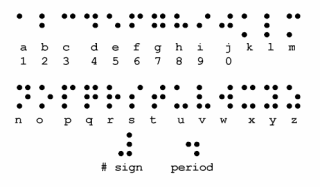
Guide dogs are assistance dogs trained to lead blind or vision impaired people around obstacles.
Although the dogs can be trained to navigate various obstacles, they are partially (red-green) color blind and are not capable of interpreting street signs. The human half of the guide dog team does the directing, based upon skills acquired through previous mobility training. The handler might be likened to an aircraft's navigator, who must know how to get from one place to another, and the dog is the pilot, who gets them there safely.
The first guide dog training schools were established in Germany during World War I, to enhance the mobility of returning veterans who were blinded in combat. The United States followed suit in 1929 with The Seeing Eye in Nashville, Tennessee. One of the founders of The Seeing Eye was America's first guide dog owner, Nashville resident Morris Frank. Frank was trained with German Shepherd Dog Buddy in Switzerland in 1928.
The first guide dogs in Britain were German Shepherds. Three of these first were Judy, Meta and Folly who were handed over to their new owners, veterans blinded in World War I, on 6 October 1931. Judy's new owner was Musgrave Frankland. This was followed, in 1934, by the start of The Guide Dogs for the Blind Association in Great Britain.
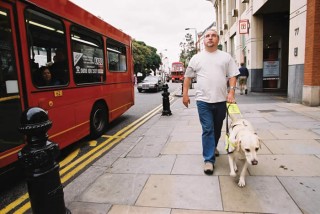
A sidewalk (chiefly North American English), pavement (British English, South African English and Philadelphia dialect), footpath (Australian English, Irish English, Indian English, Pakistani English and New Zealand English), platform (chiefly Indian English) or footway (Engineering term) is a path for pedestrians that is situated alongside a road or a paved pathway (such as a concrete footpath through a park). A sidewalk may accommodate moderate changes in grade. However, "walkway" is a more complete term for support of walking, and includes stairs, ramps, paseos (passageways) and related off-street tools that provide for a developed pathway.
Construction
While some assert that Arthur Wesley Hall and William Alexander McVay invented concrete sidewalks and partitions in St. Stephen, New Brunswick in 1924, concrete pavements from the 1860's onwards can be found in good repair all over the older districts of San Francisco, having survived the 1906 quake, and stamped with the name of the contractor and date of installation. In the 19th century and early 20th century, sidewalks of wood were common in some locations. They may still be found at historic beach locations and in conservation areas to protect the land beneath and around, called boardwalks. Contemporary sidewalks are most often made of concrete (particularly in the United States and Canada), tarmac, asphalt, brick (particularly in Europe), stone, slab or (increasingly) rubber. Multi-use paths alongside roads are sometimes made of materials that are softer than concrete, such as asphalt.
In the United States, the most common type of sidewalk consists of a poured concrete ribbon with cross-lying strain relief grooves at intervals of ~1 m; this is intended to minimize visible damage from tectonic and temperature fluctuations, both of which can crack longer segments. However, freeze-thaw cycles (in cold-weather regions) and tree root growth can eventually result in damage which requires repair. Brick sidewalks are found in some urban areas, usually for aesthetic purposes. Brick sidewalk construction usually involves the usage of a mechanical vibrator to lock the bricks in place after they have been laid (and/or to prepare the soil before laying). Although this might also be done by other tools (as regular hammers and heavy rolls), a vibrator is often used to speed up the process.
In other countries, suburban pavements are most commonly used. This kind of approach (using pavements) is more economical and sometimes more environmentally-friendly, depending on what material is used (e.g. trass instead of energy intensive Portland cement concrete or petroleum-based materials as asphalt or tar-penetration macadam). In the United Kingdom the suburban pavements are most commonly constructed of tarmac, which is however not more environmentally-friendly. In urban or inner-city areas pavements are most commonly constructed of slabs, stone, or brick depending upon the surrounding street architecture and furniture.
Stone slabs called flagstones or flags are sometimes used where an attractive appearance is required, as in historic town centres. In other places, pre-cast concrete slabs (called paving slabs or, less correctly, paving stones) are used. These may be coloured or textured to resemble stone.
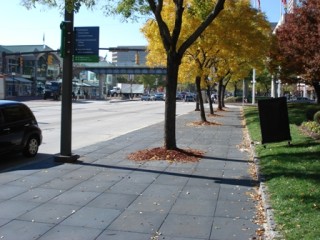
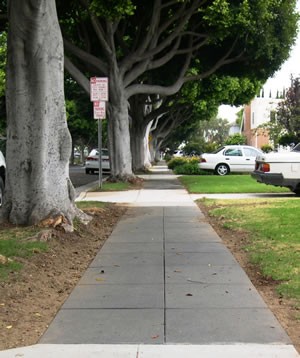
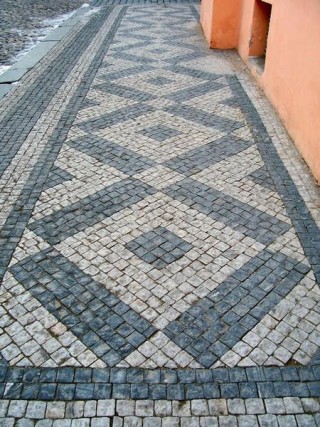
Blind man falls to death in New York lift shaft
A blind man fell to his death in an lift shaft inside a building with a history of lift violations, and authorities on Friday were investigating whether malfunctioning doors played a role.
Sheldon Scott, 67, was reported missing by his wife on Thursday afternoon, about four hours after he left their third-floor flat to go to the bank.
That evening, officers searching the 10-storey building in the Bronx found his body in the lift shaft.
Police said Scott was legally blind.
The medical examiner's office on Friday ruled the death an accident. An autopsy found Scott died of blunt impact to his head and torso.
The building has been cited for 14 lift violations since 1991, including three that were dismissed on Wednesday, according to a city website. A separate complaint logged on Thursday from a caller reporting Scott's death included a notation saying, "shaft open/unguarded."
Tony Sclafani, a city housing spokesman, said the accident was under investigation, but declined further comment. There was no response to a telephone message left with the building's owner.
Death of blind man 'tragic accident'
The death of a blind 56-year-old west Southland man was a tragic accident, police said yesterday. "It's a tragic set of circumstances. Police are not apportioning blame on anyone," said Constable Tony Vincent.
Stuart Manson, of Otautau, and his guide dog were killed on Monday when they were hit by a car on an unlit stretch of road near his home zoned 100km/h.
Blind woman killed in traffic accident identified
The blind woman who died Thursday after being struck by a car in the 8400 block of Aurora Avenue North has been identified as Jacklyn McCraw, the King County Medical Examiner's Office reported.
McCraw, 60, suffered injuries to her torso, an office spokesman said. The office has ruled her death an accident.
McCraw was walking with her guide dog on Aurora Avenue around 5:45 p.m. when a 34-year-old Volvo driver had a seizure and hit another car. That second car went onto the sidewalk and hit McCraw and her dog, Seattle police reported.
Medics took McCraw to Harborview Medical Center, where she died. Her dog, a golden retriever, was treated for a dislocated hip at a veterinary center in Wallingford.
A Seattle police spokeswoman has said department investigators consider her death to be an accident.
Blind man hurt in fall at Orinda BART station
A blind 41-year-old man was seriously injured after he fell off a BART train platform at the Orinda station Friday, halting the morning commute for nearly an hour.
The unidentified Orinda man was taken by Medivac helicopter to John Muir Medical Center in Walnut Creek for treatment of head injuries, BART police said. Police said they were withholding his name until his relatives were notified.
At 7:26 a.m., the operator of a San Francisco-bound train spotted something on the ground alongside the tracks at the edge of the station, said Lt. Gregg Savage.
"He (the operator) didn't know what it was, so he hit the emergency stop," said Savage. "One of our officers crawled along the edge of the platform to where the person was. The man had a serious head injury."
The blind man's cane was found near his body along the tracks. Police said they did not know whether he fell or was pushed from the platform, and could find no witnesses despite interviewing several people at the scene.
The accident caused the station to be shut down for more than 45 minutes. Service resumed at 8:18 a.m.
"We were all just standing there for what seemed like forever," said a commuter who boarded a train at the Pittsburg/Bay Point BART station at 7:15 a. m but didn't get to her job in San Francisco's financial district until after 9 a.m.
Unlike restaurants where people go to see and be seen, diners go to Dans le Noir and other "dark" restaurants around the globe so they can't be seen. Dining in the dark means customers are deprived of sight, so their remaining senses become heightened. Smells become more pungent. The sense of taste becomes more acute.
Since opening in Paris in 2004, Dans le Noir (In the Dark) has served more than 100,000 customers in absolute darkness. Meals are prepared by sighted cooks in a separate lighted area. Drinks are concocted by a sighted bartender. But the entire wait staff is blind.
Cellphones are confiscated before guests are allowed to enter the dining room. Matches, cigarette lighters, luminous wristwatches — anything capable of emitting light is strictly forbidden.
This unusual dining experience offers a culinary adventure. But it also provides employment opportunities for visually impaired people — something that creates an interesting role reversal. Within the confines of Dans le Noir, the sighted become temporarily sightless. Having memorized the location of every chair, table and passageway in the 58-seat restaurant, blind waiters become our eyes.



































































































